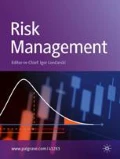Abstract
The paper deals with the construction of required capital to cover the default risk in portfolios with a smaller number of heterogeneous counterparties. The typical application is counterparty default risk of reinsurance (e.g., in Solvency II), but other applications in finance are also possible. Since the approach by means of Vasicek portfolio model is questionable in such cases the paper addresses mainly the approach based on the so-called common shock principle. An extensive numerical study compares results of various methods which are applicable in this context. The numerical results confirm that the suggested modifications of the widely accepted common shock approach implemented within the Solvency II framework might be preferred by insurance companies when constructing the portfolio of reinsurers.


















Similar content being viewed by others
References
Artzner, P., et al. 1999. Coherent measures of risk. Mathematical Finance 9: 203–228.
Basel II. 2006. International convergence of capital measurements and capital standards. Basel: Basel Committee on Banking Supervision.
Basel III. 2010. A global regulatory framework for more resilient banks and banking systems. Basel: Bank for International Settlements.
Benink, H.A., N. Hyung, and C.G. de Vries. 2013. Evaluation of bank systemic risk. The economics of banking and finance documents. Tilburg: Tilburg University.
Britt, S., and Y. Krvavych. 2009. Reinsurance credit risk modeling. Manchester: ASTIN Colloquium.
CEIOPS’ advice for level 2 implementing measures on Solvency II: SCR standard formula—Counterparty default risk module. 2009. https://eiopa.europa.eu/CEIOPS-Archive/Documents/Advices/CEIOPS-L2-Final-Advice-SCR-SF-Counterparty-default-risk.pdf. Accessed 15 Jan 2018.
Cipra, T. 2010. Financial and insurance formulas. New York: Springer.
Cipra, T., and R. Hendrych. 2017. Systemic risk in financial risk regulation. Czech Journal of Economics and Finance 67: 15–38.
Flower, M., et al. 2007. Reinsurance counterparty credit risks. London: GIRO Working Party, Institute of Actuaries (UK).
Hürlimann, W. 2003. Conditional value-at-risk bounds for compound Poisson risks and a normal approximation. Journal of Applied Matematics 3: 141–154.
Hürlimann, W. 2008. Solvency reinsurance counterparty default risk. Life & Pension, 39–44.
McNeil, A.J., R. Frey, and P. Embrechts. 2005. Quantitative risk management. Princeton: Princeton University Press.
QIS3. 2007. Calibration of the credit risk. CEIOPS quantitative impact study 3. http://www.ceiops.org. Accessed 15 Jan 2018.
QIS4. 2008. Technical specifications. CEIOPS quantitative impact study 4. http://www.ceiops.org. Accessed 15 Jan 2018.
QIS5. 2011. Report. EIOPA quantitative impact study 5. https://eiopa.europa.eu/publications/reports/qis5_report_final.pdf. Accessed 15 Jan 2018.
Quick, R. and D. Weglarz. 2012. Reinsurance default risk. Gen Re, Insurance Issues. http://media.genre.com/documents/InsuranceIssues201210-en.pdf. Accessed 15 Jan 2018.
Sachs, R. 2009. Reinsurance credit risk. Technical report, 267–285. Munich: Munich Re Group.
Sandström, A. 2011. Handbook of solvency for actuaries and risk managers. Theory and practice. Boca Raton: Chapman and Hall/CRC Press.
Solvency II. 2009. Directive on the taking-up and pursuit of the business of insurance and reinsurance. Directive 2009/138/EC of the European Parliament and of the Council 2009.
ter Berg, P. 2008. Portfolio modelling of counterparty reinsurance default risk. Life & Pension, 29–33.
Vasicek, O.A. 2002. The distribution of loan portfolio value. Risk 15: 160–162.
Acknowledgements
This research was supported by the grant 17–00676S provided by the Grant Agency of the Czech Republic.
Author information
Authors and Affiliations
Corresponding author
Appendix
Appendix
Derivation of (17)
For instance, to derive σij for i ≠ j one can write using (13):
The derivation for i = j is analogous.
Derivation of (24)
Derivation of (26)
Derivation of (27)
It holds
Hence
so that (27) is proved.
Rights and permissions
About this article
Cite this article
Hendrych, R., Cipra, T. Common shock approach to counterparty default risk of reinsurance. Risk Manag 21, 123–151 (2019). https://doi.org/10.1057/s41283-018-0045-0
Published:
Issue Date:
DOI: https://doi.org/10.1057/s41283-018-0045-0




